engine SKODA SUPERB 2004 1.G / (B5/3U) Manual PDF
[x] Cancel search | Manufacturer: SKODA, Model Year: 2004, Model line: SUPERB, Model: SKODA SUPERB 2004 1.G / (B5/3U)Pages: 270
Page 220 of 270
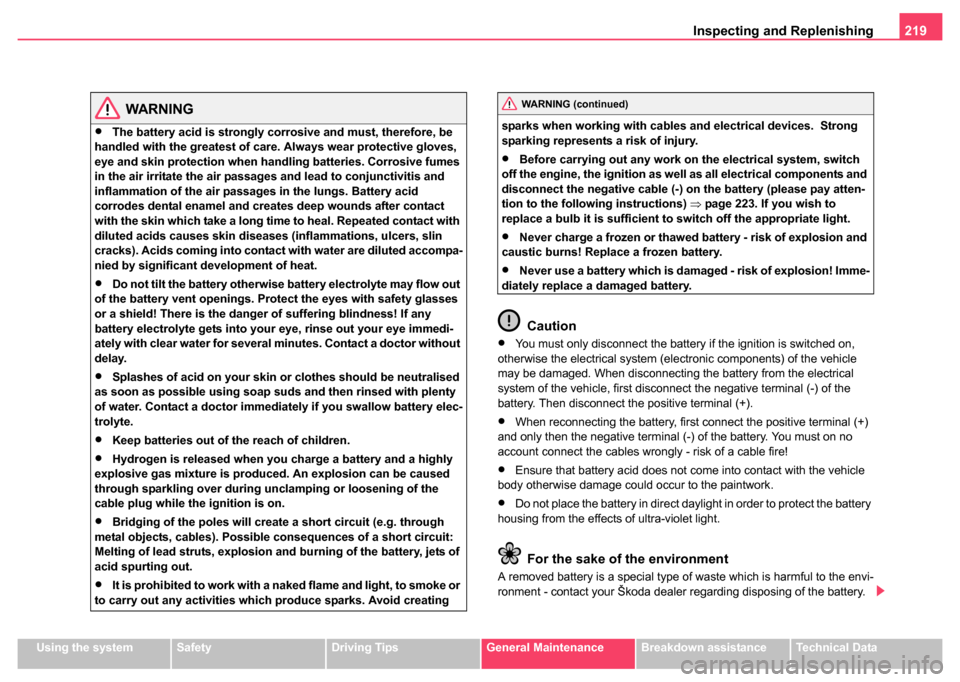
Inspecting and Replenishing219
Using the systemSafetyDriving TipsGeneral MaintenanceBreakdown assistanceTechnical Data
WARNING
•The battery acid is strongly corrosive and must, therefore, be
handled with the greatest of care. Always wear protective gloves,
eye and skin protection when handling batteries. Corrosive fumes
in the air irritate the air passages and lead to conjunctivitis and
inflammation of the air passages in the lungs. Battery acid
corrodes dental enamel and creates deep wounds after contact
with the skin which take a long time to heal. Repeated contact with
diluted acids causes skin diseases (inflammations, ulcers, slin
cracks). Acids coming into contact with water are diluted accompa-
nied by significant development of heat.
•Do not tilt the battery otherwise battery electrolyte may flow out
of the battery vent openings. Protect the eyes with safety glasses
or a shield! There is the danger of suffering blindness! If any
battery electrolyte gets into your eye, rinse out your eye immedi-
ately with clear water for several minutes. Contact a doctor without
delay.
•Splashes of acid on your skin or clothes should be neutralised
as soon as possible using soap suds and then rinsed with plenty
of water. Contact a doctor immediately if you swallow battery elec-
trolyte.
•Keep batteries out of the reach of children.
•Hydrogen is released when you charge a battery and a highly
explosive gas mixture is produced. An explosion can be caused
through sparkling over during unclamping or loosening of the
cable plug while the ignition is on.
•Bridging of the poles will create a short circuit (e.g. through
metal objects, cables). Possible consequences of a short circuit:
Melting of lead struts, explosion and burning of the battery, jets of
acid spurting out.
•It is prohibited to work with a naked flame and light, to smoke or
to carry out any activities which produce sparks. Avoid creating sparks when working with cables and electrical devices. Strong
sparking represents a risk of injury.
•Before carrying out any work on the electrical system, switch
off the engine, the ignition as well as all electrical components and
disconnect the negative cable (-) on the battery (please pay atten-
tion to the following instructions) ⇒page 223. If you wish to
replace a bulb it is sufficient to switch off the appropriate light.
•Never charge a frozen or thawed battery - risk of explosion and
caustic burns! Replace a frozen battery.
•Never use a battery which is damaged - risk of explosion! Imme-
diately replace a damaged battery.
Caution
•You must only disconnect the battery if the ignition is switched on,
otherwise the electrical system (electronic components) of the vehicle
may be damaged. When disconnecting the battery from the electrical
system of the vehicle, first disconnect the negative terminal (-) of the
battery. Then disconnect the positive terminal (+).
•When reconnecting the battery, first connect the positive terminal (+)
and only then the negative terminal (-) of the battery. You must on no
account connect the cables wrongly - risk of a cable fire!
•Ensure that battery acid does not come into contact with the vehicle
body otherwise damage could occur to the paintwork.
•Do not place the battery in direct daylight in order to protect the battery
housing from the effects of ultra-violet light.
For the sake of the environment
A removed battery is a special type of waste which is harmful to the envi-
ronment - contact your Škoda dealer regarding disposing of the battery.
WARNING (continued)
Page 221 of 270

Inspecting and Replenishing
220
Note
Please also refer to the guidelines ⇒page 223, “Disconnecting and
reconnecting the battery”, also after connecting the battery.
Battery with a charge level indicator, the so-called
magic eye
There is a so-called magic eye ⇒fig. 165 located on the top of the battery.
The “magic eye” changes its colour in line with the charge state of and
electrolyte level in the battery.
Air bubbles can influence the colour of the “magic eye”. For this reason
carefully knock on the “magic eye” before carrying out the check.
•Green colour - the battery is adequately charged.
•Dark colour - the battery has to be charged
•Colourless or yellow - the electrolyte level is too low, no indication
r
egarding the charge state is possible. The battery must be replenished
with distilled water.
Batteries, which are more than 5 years old, must be replaced. We recom-
mend you have the electrolyte level inspected and adjusted to the correct
level or the battery replaced if necessary by a Škoda dealer.
Caution
If the vehicle has not been driven for more than 3 to 4 weeks, the battery
will discharge gradually as a result from electrical components such as the
control units which were not switched off. You can prevent the discharging
of the battery by disconnecting the negative terminal or charging the
battery constantly with a very low charging current. Please also refer to
the notes when working on the battery ⇒page 218, “Working on the
battery”.
Inspecting the electrolyte level
The battery is practically maintenance-free under normal operating
conditions. We do, however, recommend that you have the electrolyte
level inspected from time to time by a Škoda dealer when outside temper-
atures are high or when driving on long trips. You should also check the
electrolyte level ⇒page 221 each time the battery is charged.
The battery acid level will also be checked as part of the Inspection
Service.Fig. 165 Engine
compartment: Battery
with magic eye
Page 222 of 270

Inspecting and Replenishing221
Using the systemSafetyDriving TipsGeneral MaintenanceBreakdown assistanceTechnical Data
Operation in winter
The battery has to provide greater amounts of electricity during the winter.
It also has only part of the initial power output at low temperatures that it
has at normal temperatures.
A discharged battery may already freeze at temperatures just below
0°C.
We therefore recommend that you have the battery checked by a Škoda
dealer before the start of the winter, and recharged if necessary.
Note
If the vehicle is not going to be driven for a period of some weeks when
there is very severe frost one should remove ⇒page 222 the battery and
store it in a place which is protected from frost. This prevents the battery
from freezing up and thereby being destroyed.
Charging the battery
A properly charged battery is essential for reliably starting
the engine.
– Read the warning notes ⇒ in “Working on the battery” on
page 218 and ⇒.
– Switch the ignition and all electrical components off.
– Only for “quick-charging”: disconnect both battery cables (first of all “negative”, then “positive”) .
– Carefully attach the terminal clamps of the charger to the battery terminals (red = “positive”, black = “negative”). – You can now plug the mains cable of the charger into the
power socket and switch on the charger.
– When charging is completed: switch the charger off and unplug the mains cable from the power socket.
– Only then should you disconnect the terminal clamps of the charger.
– Reconnect the cables to the battery (first of all “positive”, then “negative”).
It is not normally necessary to disconnect the cables of the battery if you
recharge the battery using low amperages (as for example from a mini-
charger ). Please also refer to the instructions from the charger manufac-
turer.
A charging current of 0.1 of the total battery capacity (or lower) is that
which should be used until full charging is achieved.
It is, however, necessary to disconnect both cables before charging the
battery with high amperages, so-called “ quick-charging”.
“Quick-charging” a battery is dangerous ⇒ in “Working on the battery”
on page 218. It requires a special charger and appropriate knowledge. We
therefore recommend that you have your battery quick-charged only by
your Škoda dealer.
A discharged battery may already freeze at temperatures just below 0°C.
If a battery is frozen, it is essential that it is first of all thawed out before
being charged ⇒. We recommend that you no longer use a battery
which has thawed out because the casing of the battery may be cracked
through the formation of ice and this would allow battery electrolyte to flow
out.
The vent plugs of the battery should not be opened for charging.
Page 223 of 270

Inspecting and Replenishing
222
WARNING
Never charge a battery which is frozen - risk of explosion!
Removing and installing the battery
Removing and installing the battery
– Please also refer to the notes when working on the battery
⇒page 218.
– Switched off all electrical components and remove the ignition key.
– Pull off gasket and take out the cover of the plenum chamber in the direction of the arrow ⇒fig. 166 .
– Unclamp the battery negative terminal (-).
– Unclamp the battery positive terminal (+).
– Unscrew the screw ⇒fig. 167 completely and remove the
locking plate.
– Move the battery in the direction of the arrow and pull it out in an upward direction.
Fig. 166 Engine
compartment: plenum
chamber - cover
Fig. 167 Engine
compartment: The
battery
AA
AB
AC
Page 224 of 270
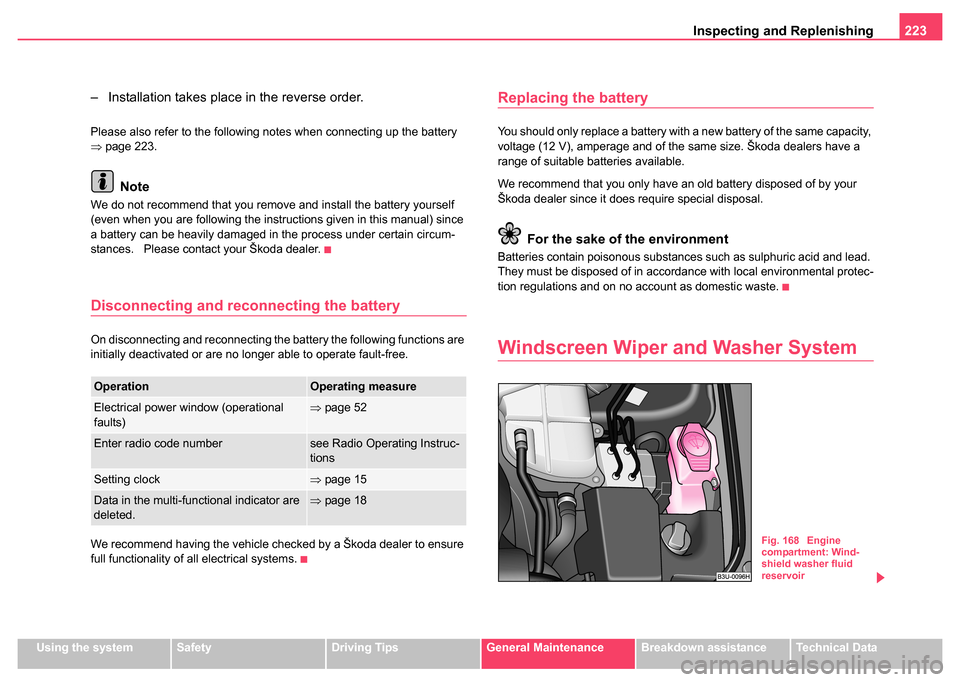
Inspecting and Replenishing223
Using the systemSafetyDriving TipsGeneral MaintenanceBreakdown assistanceTechnical Data
– Installation takes place in the reverse order.
Please also refer to the following notes when connecting up the battery
⇒page 223.
Note
We do not recommend that you remove and install the battery yourself
(even when you are following the instructions given in this manual) since
a battery can be heavily damaged in the process under certain circum-
stances. Please contact your Škoda dealer.
Disconnecting and reconnecting the battery
On disconnecting and reconnecting the battery the following functions are
initially deactivated or are no longer able to operate fault-free.
We recommend having the vehicle checked by a Škoda dealer to ensure
full functionality of all electrical systems.
Replacing the battery
You should only replace a battery with a new battery of the same capacity,
voltage (12 V), amperage and of the same size. Škoda dealers have a
range of suitable batteries available.
We recommend that you only have an old battery disposed of by your
Škoda dealer since it does require special disposal.
For the sake of the environment
Batteries contain poisonous substances such as sulphuric acid and lead.
They must be disposed of in accordance with local environmental protec-
tion regulations and on no account as domestic waste.
Windscreen Wiper and Washer System
OperationOperating measure
Electrical power window (operational
faults) ⇒page 52
Enter radio code numbersee Radio Operating Instruc-
tions
Setting clock⇒page 15
Data in the multi-functional indicator are
deleted.⇒page 18
Fig. 168 Engine
compartment: Wind-
shield washer fluid
reservoir
Page 225 of 270
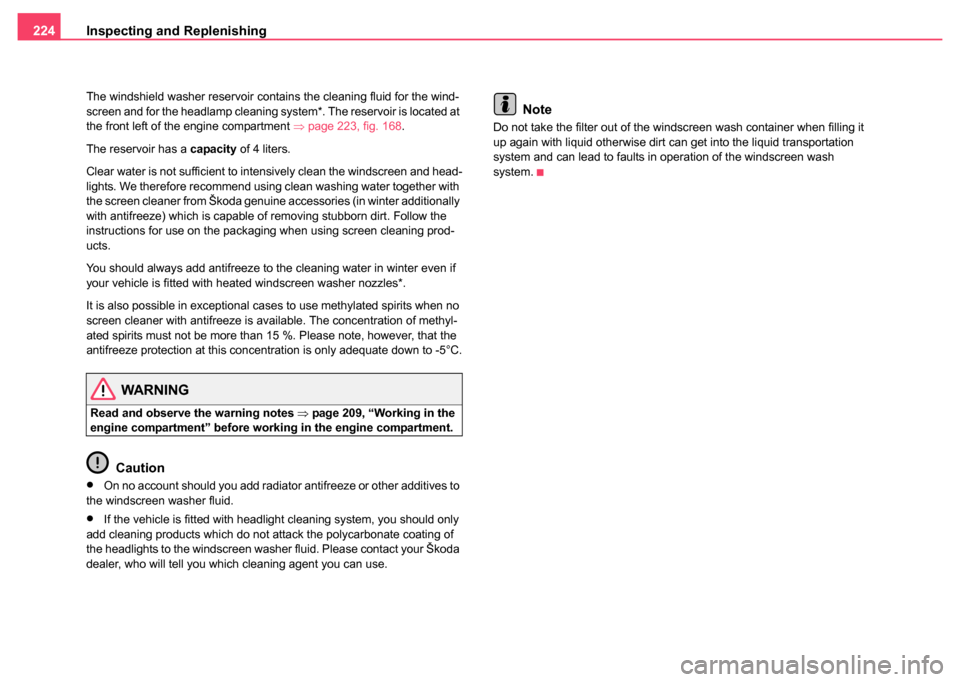
Inspecting and Replenishing
224
The windshield washer reservoir contains the cleaning fluid for the wind-
screen and for the headlamp cleaning system*. The reservoir is located at
the front left of the engine compartment ⇒ page 223, fig. 168.
The reservoir has a capacity of 4 liters.
Clear water is not sufficient to intensively clean the windscreen and head-
lights. We therefore recommend using clean washing water together with
the screen cleaner from Škoda genuine accessories (in winter additionally
with antifreeze) which is capable of removing stubborn dirt. Follow the
instructions for use on the packaging when using screen cleaning prod-
ucts.
You should always add antifreeze to the cleaning water in winter even if
your vehicle is fitted with heated windscreen washer nozzles*.
It is also possible in exceptional cases to use methylated spirits when no
screen cleaner with antifreeze is available. The concentration of methyl-
ated spirits must not be more than 15 %. Please note, however, that the
antifreeze protection at this concentration is only adequate down to -5°C.
WARNING
Read and observe the warning notes ⇒page 209, “Working in the
engine compartment” before working in the engine compartment.
Caution
•On no account should you add radiator antifreeze or other additives to
the windscreen washer fluid.
•If the vehicle is fitted with headlight cleaning system, you should only
add cleaning products which do not attack the polycarbonate coating of
the headlights to the windscreen washer fluid. Please contact your Škoda
dealer, who will tell you which cleaning agent you can use.
Note
Do not take the filter out of the windscreen wash container when filling it
up again with liquid otherwise dirt can get into the liquid transportation
system and can lead to faults in operation of the windscreen wash
system.
Page 234 of 270

Accessories, changes and replacement of parts233
Using the systemSafetyDriving TipsGeneral MaintenanceBreakdown assistanceTechnical Data
Accessories, changes and replacement of parts
Accessories and replacement parts
Škoda vehicles have been built according to the latest discoveries in
safety engineering. Thus one should not change the condition in which the
vehicle was delivered from the manufacturer without some thought.
The following guidelines should be observed when a vehicle is to be retro-
fitted with accessories, have technical changes made to it or a part has to
be replaced at some time in the future.
•Advise should always be obtained from a Škoda dealer before buying
any accessories and before making any technical changes ⇒.
•This is particularly the case when accessories are bought in a foreign
country.
•Škoda Genuine Accessories which have been released for use and
Skoda original parts can be obtained from Škoda dealers. They will install
them professionally and correctly.
•All Škoda original accessories which are listed in the catalogue such
as tilting roofs, spoilers, wheels etc. must have an official stamp of
approval.
•Radios, aerials and other electrical accessories should only be
installed by an authorised workshop.
•The guidelines issued by Škoda Auto must be observed when making
technical changes.
•This is to ensure that no technical damage occurs to the vehicle, that
travelling and operating safety are maintained and that the chnages are
permissible. Škoda dealers undertake this work professionally or refer it
to an specialist company in special cases.
Any damage which is done caused by technical changes made
without consulting a Škoda Auto is excluded from the warranty.
WARNING
•We advise you, in your own interest, to only use Škoda Genuine
Accessories and Škoda original parts which have been expressly
approved for use on your Škoda. Reliability, safety and suitabiliity
have been established for these Škoda original parts.
•We cannot guarantee suitability of installation into your vehicle
of other products despite keeping a constant eye on market devel-
opments (also not in the case where there is an attestation or
permission can be produced).
Technical changes
Interference on the electronic components and their software can lead to
operational faults. This interference can also impair not directly affected
systems because of the networking of the electronic components. This
means that the operating safety of your vehicle can be considerably jeop-
ardized, a greater wear of vehicle parts can occur and finally the vehicle
registration documents expire.
We trust that you will understand that your Škoda dealer cannot be liable
for damage resulting from unprofessional work.
We therefore recommend that you have all work carried out with Škoda
original parts at your authorised Škoda dealer.
Page 239 of 270

Breakdown assistance
238
•Do not drive with this spare wheel at more than 80 km/h - risk of acci-
dent. Avoid accelerating at full throttle, sharp braking and fast cornering.
•The inflation pressure for this spare wheel is identical to the inflation
pressure of the standard tyres.
•Use this spare wheel only to reach the nearest service station as it is
not intended for continuous use.
Changing a wheel
Preliminary work
The following steps should be carried out before actually
changing the wheel.
– If it is necessary to change a wheel, park the vehicle as far away as possible from the traffic flow. The place you choose
should be level.
– Have all the occupants get out. While changing a wheel, the
occupants of the vehicle should not stand on the road (it is
better behind a crash barrier).
– Apply the handbrake firmly.
– Engage 1st gear or if your vehicle is fitted with an automatic
gearbox, position the selector lever into position P .
– If a trailer is coupled, uncouple it.
– Take the vehicle tool kit and the spare wheel ⇒ page 237
out of the luggage compartment.
WARNING
•If you find yourself in flowing traffic switch on the hazard
warning lights system and place the warning triangle on the side of
the road at the prescribed distance from your vehicle while
observing all national legal provisions. In this way you are
protecting not only yourself but also other road users.
•Never start the engine with the vehicle sitting on the raised jack
- danger of suffering injury!
Caution
If you have to change a wheel on a slope first block the opposite wheel
with a stone or similar object in order to secure the vehicle from unexpect-
edly rolling away.
Note
Comply with the national legal regulations.
Changing a wheel
Always change a wheel on a level surface as far as possible.
– Take off the full wheel trim* ⇒page 239 or the caps
⇒ page 241.
– In the case of light alloy wheels remove the wheel trim cap ⇒page 240.
– Slacken the wheel bolts ⇒page 241.
Page 243 of 270
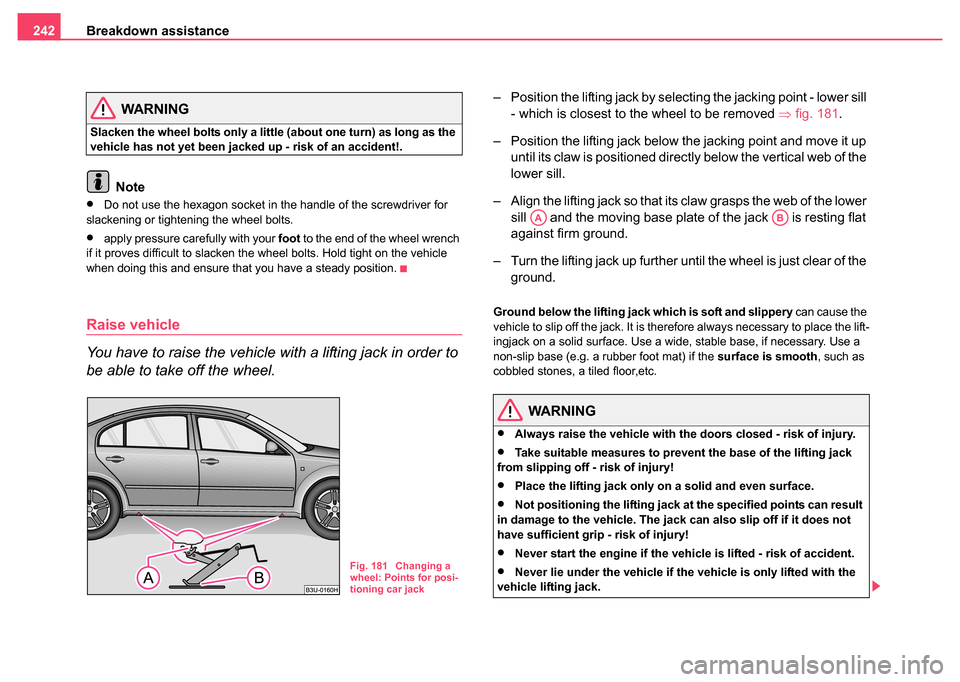
Breakdown assistance
242
WARNING
Slacken the wheel bolts only a little (about one turn) as long as the
vehicle has not yet been jacked up - risk of an accident!.
Note
•Do not use the hexagon socket in the handle of the screwdriver for
slackening or tightening the wheel bolts.
•apply pressure carefully with your foot to the end of the wheel wrench
if it proves difficult to slacken the wheel bolts. Hold tight on the vehicle
when doing this and ensure that you have a steady position.
Raise vehicle
You have to raise the vehicle with a lifting jack in order to
be able to take off the wheel.
– Position the lifting jack by selecting the jacking point - lower sill - which is closest to the wheel to be removed ⇒fig. 181.
– Position the lifting jack below the jacking point and move it up until its claw is positioned directly below the vertical web of the
lower sill.
– Align the lifting jack so that its claw grasps the web of the lower sill and the moving base plate of the jack is resting flat
against firm ground.
– Turn the lifting jack up further until the wheel is just clear of the ground.
Ground below the lifting jack which is soft and slippery can cause the
vehicle to slip off the jack. It is therefore always necessary to place the lift-
ingjack on a solid surface. Use a wide, stable base, if necessary. Use a
non-slip base (e.g. a rubber foot mat) if the surface is smooth, such as
cobbled stones, a tiled floor,etc.
WARNING
•Always raise the vehicle with the doors closed - risk of injury.
•Take suitable measures to prevent the base of the lifting jack
from slipping off - risk of injury!
•Place the lifting jack only on a solid and even surface.
•Not positioning the lifting jack at the specified points can result
in damage to the vehicle. The jack can also slip off if it does not
have sufficient grip - risk of injury!
•Never start the engine if the vehicle is lifted - risk of accident.
•Never lie under the vehicle if the vehicle is only lifted with the
vehicle lifting jack.Fig. 181 Changing a
wheel: Points for posi-
tioning car jack
AAAB
Page 246 of 270
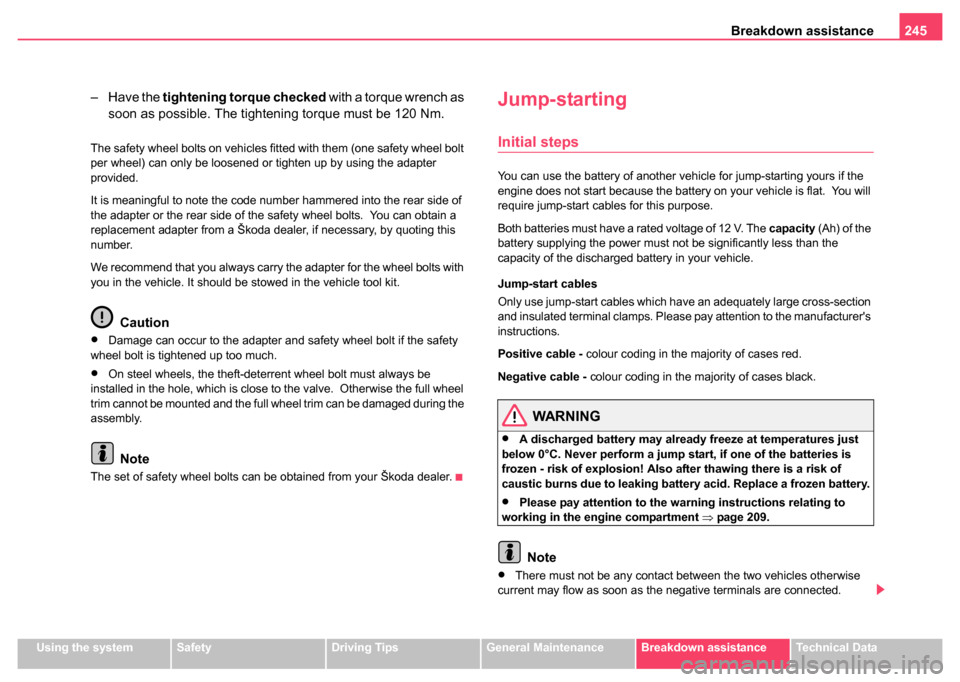
Breakdown assistance245
Using the systemSafetyDriving TipsGeneral MaintenanceBreakdown assistanceTechnical Data
– Have the tightening torque checked with a torque wrench as
soon as possible. The tightening torque must be 120 Nm.
The safety wheel bolts on vehicles fitted with them (one safety wheel bolt
per wheel) can only be loosened or tighten up by using the adapter
provided.
It is meaningful to note the code number hammered into the rear side of
the adapter or the rear side of the safety wheel bolts. You can obtain a
replacement adapter from a Škoda dealer, if necessary, by quoting this
number.
We recommend that you always carry the adapter for the wheel bolts with
you in the vehicle. It should be stowed in the vehicle tool kit.
Caution
•Damage can occur to the adapter and safety wheel bolt if the safety
wheel bolt is tightened up too much.
•On steel wheels, the theft-deterrent wheel bolt must always be
installed in the hole, which is close to the valve. Otherwise the full wheel
trim cannot be mounted and the full wheel trim can be damaged during the
assembly.
Note
The set of safety wheel bolts can be obtained from your Škoda dealer.
Jump-starting
Initial steps
You can use the battery of another vehicle for jump-starting yours if the
engine does not start because the battery on your vehicle is flat. You will
require jump-start cables for this purpose.
Both batteries must have a rated voltage of 12 V. The capacity (Ah) of the
battery supplying the power must not be significantly less than the
capacity of the discharged battery in your vehicle.
Jump-start cables
Only use jump-start cables which have an adequately large cross-section
and insulated terminal clamps. Please pay attention to the manufacturer's
instructions.
Positive cable - colour coding in the majority of cases red.
Negative cable - colour coding in the majority of cases black.
WARNING
•A discharged battery may already freeze at temperatures just
below 0°C. Never perform a jump start, if one of the batteries is
frozen - risk of explosion! Also after thawing there is a risk of
caustic burns due to leaking battery acid. Replace a frozen battery.
•Please pay attention to the warning instructions relating to
working in the engine compartment ⇒page 209.
Note
•There must not be any contact between the two vehicles otherwise
current may flow as soon as the negative terminals are connected.